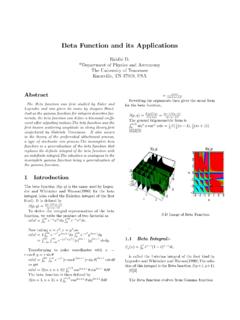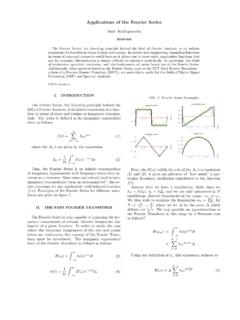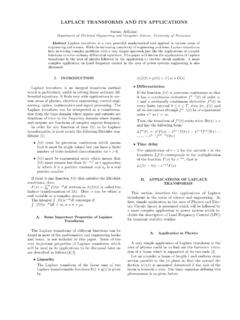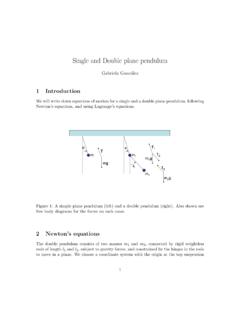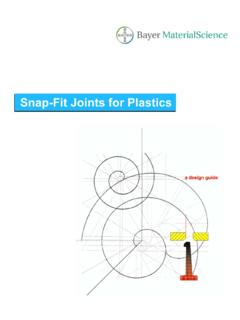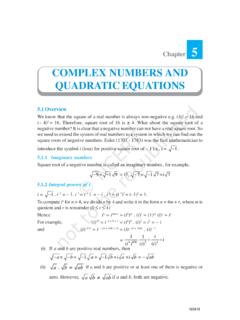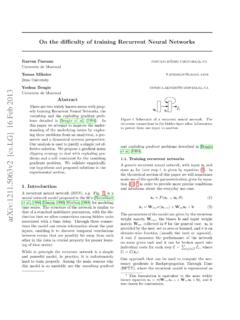Transcription of Bessel Functions and Their Applications
1 Bessel Functions and Their ApplicationsJennifer Niedziela University of Tennessee - Knoxville(Dated: October 29, 2008) Bessel Functions are a series of solutions to a second order differential equation that arise inmany diverse situations. This paper derives the Bessel Functions through use of a series solutionto a differential equation, develops the different kinds of Bessel Functions , and explores the topicof zeroes. Finally, Bessel Functions are found to be the solution to the Schroedinger equation in asituation with cylindrical special types of what would later be known asBessel Functions were studied by Euler, Lagrange, andthe Bernoullis, the Bessel Functions were first used by Bessel to describe three body motion, with the Besselfunctions appearing in the series expansion on planetaryperturbation [1].
2 This paper presents the Bessel func-tions as arising from the solution of a differential equa -tion; an equation which appears frequently in applica-tions and solutions to physical situations [2] [3]. Fre-quently, the key to solving such problems is to recognizethe form of this equation, thus allowing employment ofthe Bessel Functions as solutions. The subject of BesselFunctions and Applications is a very rich subject; never-theless, due to space and time restrictions and in the in-terest of studying Applications , the Bessel function shallbe presented as a series solution to a second order dif-ferential equation, and then applied to a situation withcylindrical symmetry. Appropriate development of ze-roes, modified Bessel Functions , and the application ofboundary conditions will be briefly Bessel EQUATIONB essel s equation is a second order differential equationof the formx2y +xy + (x2 2)y= 0(1)By re-writing this equation as:x(xy ) + (x2 2)y= 0(2)and employing the use of a generalized power series, were-write the terms of (2) in terms of the series:y= n=0anxn+sy = n=0an(n+s)xn+s 1xy = n=0an(n+s)xn+s(xy ) = n=0an(n+s)2xn+s 1(xy ) = n=0an(n+s)2xn+sWhen the coefficients of the powers of x are organized, wefind that the coefficient onxsgives the indicial equations2 2= 0,= s= , and we develop the generalformula for the coefficient on thexs+nterm:an= an 2(n+s)2 2(3)In the cases=.
3 An= an 2n(n+ 2 )(4)and sincea1= 0,an= 0 for alln=oddintegers. Coeffi-cients for even powers ofnare found:a2n= a2n 222n(n+ )(5)Recalling that for the gamma function: ( + 2) = ( + 1) ( + 1), ( + 3) = ( + 2) ( + 2) = ( + 2)( + 1) ( + 1),we can write the coefficients:a2= a022(1 + )= (1 + )22 (2 + )a2n= a0 (1 + )n!22n (n+ 1 + )Which allows us to write the terms of the series :y=J (x) = n=0( 1)n (n+ 1) (n+ + 1)(x2)2n+ (6)WhereJ (x) is the Bessel function of the first kind, order . The first five Bessel Functions of this kind are shownin figure 1: The Bessel Functions of orders = 0 to = 5 DIFFERENT ORDERS OF Bessel FUNCTIONSIn the preceding section, the form of Bessel functionswere obtained are known as Bessel Functions of the firstkind. [3]. Different kinds of Bessel Functions are obtainedwith negative values of , or with complex section briefly explores these different kinds of func-tionsNeumann FunctionsBessel Functions of the second kind are known as Neu-mann Functions , and are developed as a linear combina-tion of Bessel Functions of the first order described:N (x) =cos J (x) J (x)sin (7)For integral values of , the expression ofN (x) has anindeterminate form, andN (x)|x=0=.
4 Neverthelessthe limit of this function for x6= 0, the expression forN is valid for any value of , allowing the general solutionto Bessel s equation to be written:y=AJ (x) +BN (x)(8)with A and B as arbitrary constants determined fromboundary Functions of the first and second kind are themost commonly found forms of the Bessel function in ap-plications. Many Applications in hydrodynamics, elastic-ity, and oscillatory systems have solutions that are basedon the Bessel Functions . One such example is that of auniform density chain fixed at one end undergoing smalloscillations. The differential equation of this situation is:d2udz2+1zdudz+k2uz= 0(9)wherezreferences a point on the chain,k2=p2g, withpas the frequency of small oscillations at that point, andgthe gravitational constant of acceleration.
5 Eq. (9) is aform of eq. (1), and solution is:u=AJ0(2kz12) +BY0(2kz12),(10)where the A and B are determined by the boundary Bessel FunctionsModified Bessel Functions are found as solutions to themodified Bessel equationx2y +xy (x2 2)y= 0(11)which transforms into eq. (1) whenxis replaced withix. However, this leaves the general solution of eq. (1)a complex function ofx. To avoid dealing with complexsolutions in practical Applications [2], the solutions to(11) are expressed in the form:I (x) =e i2J (xei 2)(12)TheI (x) are a set of Functions known as the modifiedBessel Functions of the first kind. The general solution ofthe modified Bessel function is expressed as a combina-tion ofI (x) and a functionI (x):y=AI (x) BI (x)(13)where again A and B are determined from the solution for non-integer orders of is found:K (x) = 2I (x) I (x)sin (14)The functionsK (x) are known as modified Bessel func-tions of the second kind.
6 A plot of the Neumann Func-tions (N (x)) and Modified Bessel Functions (I (x))isshown in figure (2). A plot of the Modified Second Kindfunctions (Kn(x)) is shown in fig. (3).Modified Bessel Functions appear less frequently in ap-plications, but can be found in transmission line studies,non-uniform beams, and the statistical treatment of arelativistic gas in statistical of Bessel FunctionsThe zeroes of Bessel Functions are of great importancein Applications [5]. The zeroes, or roots, of the Besselfunctions are the values of x where value of the Besselfunction goes to zero (J (x) = 0). Frequently, the ze-roes are found in tabulated formats, as they must the benumerically evaluated [5]. Bessel function s of the first3 FIG. 2: The Neumann Functions (black) and the ModifiedBessel Functions (blue) for integer orders = 0 to = 5 FIG.
7 3: The Modified Bessel Functions of the second kind fororders = 0 to = 5 [4]and second kind have an infinite number of zeros as thevalue ofxgoes to . The zeroes of the Functions can beseen in the crossing points of the graphs in figure ( 1),and figure ( 2). The modified Bessel Functions of the firstkind (I (x)) have only one zero at the pointx= 0, andthe modified Bessel equations of the second kind (K (x)) Functions do not have function zeros are exploited in frequency modu-lated (FM) radio transmission. FM transmission is math-ematically represented by a harmonic distribution of asine wave carrier modulated by a sine wave signal whichcan be represented with Bessel Functions . The carrieror sideband frequencies disappear when the modulationindex (the peak frequency deviation divided by the mod-ulation frequency) is equal to the zero crossing of thefunction for - SOLUTION TOSCHROEDINGER S EQUATION IN ACYLINDRICAL WELLC onsider a particle of massmplaced into a two-dimensional potential well, where the potential is zeroinside of the radius of the disk, infinite outside of theradius of the disk.
8 In polar coordinates using r, asrepresentatives of the system, the Laplacian is written: 2 =1r r(r r)+1r2 2 2.(15)Which in the Schroedinger equation presents: h22m[1r r(r r)+1r2 2 2]=E .(16)Using the method of separation of variables with a pro-posed solution =R(r)T( ) in (16), produces h22m[T( )1R(r) r(r R(r) r)+1r2R(r) 2T 2]=ER(r)T( )(17)and then dividing by :[1R1r r(r R r)+1r21T 2T 2]= 2mE h2(18)setting2mE h2=k2and multiplying through byr2pro-ducesrRddr(rdRdr)+k2r2+1Td2Td 2= 0(19)which is fully separated inrand . To solve, the dependent portion is set to m2, yielding the harmonicoscillator equation inT( ), which presents the solution:T( ) =Aeim (20)Where A is a constant determined via proper normaliza-tion in : 2 0A2T( )T( )d = 1 = A= 12 (21)Leaving the dependent portionT( ) = 12 eim Working now with therdependent portion of the sep-arated equation, multiplying therdependent portion of(19) byr2, and setting equal tom2one obtains:r2Rd2 Rdr2+rRdRdr+k2r2=m2(22)4which when rearranged:r2d2 Rdr2+rdRdr+ (k2r2 m2) = 0(23)which is of the same form as eq.
9 (1), Bessel s differentialequation. The general solution to eq. (23) is of the formof eq. (8), and we write that general solution:R(r) =AJm(kr) +BNm(kr),(24)whereJm(kr) andNm(kr) are respectively the Besseland Neumann Functions of orderm, and A and B areconstants to be determined via application of the bound-ary conditions. As the solution must be finite atx= 0,and asNm(kr) asx 0, this means that the coef-ficient ofNm(kr) =B= 0, leavingR(r) to be expressed:R(r) =AJm(kr)(25)Using the boundary condition that = 0 at the radius ofthe disk, we have the condition thatJm(krb) = 0, whichimplicitly requires the argument ofJmto be a zero of theBessel function. As noted earlier, these zeroes must becalculated individually in numerical fashion. Requiringthatkrb= m,n, which is thenthzero of themthor-der Bessel function[6], the energy of the system is solvedby expressingkin terms of m,nin ( 2mE h2),arriving at:Em,n= 2m,n h22mr2bh(26)The full solution for is thus: m(r, ) =AJm( m,nrrb)eim (27)Because the Bessel function zeroes cannot be determinedapriori, it is difficult to find a closed solution to expressthe normalization constantA.
10 We select an order formto continue with the determination of the normalizationconstant, and arbitrarily choosem= 2, which has a zeroatr= , which we will set to be the radius of thecircle. Given the preceding, the normalization can be forthem= 2,n= 1 case can be found: rboundary0A2J2( 2,1rrb)J2( 2,1rrb)dr= 1(28)which forrboundary= = A= , (nu-merical values obtained using numerical integration inMathematica). Thus, we can express the full solution forthem= 2 scenario: (r, ) = 12 J2( 2,1rrb)eim (29)And since we ve effectively set m,n=rb, (r, ) = 12 J2(r)eim (30)Admittedly, this solution is somewhat contrived, but itshows the importance of working with the zeroes of theBessel function to generate the particular solution usingthe boundary Bessel Functions appear in many diverse scenar-ios, particularly situations involving cylindrical symme-try.
